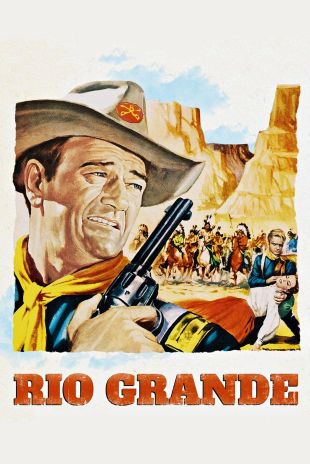
Rio Grande was the third part of John Ford's renowned "Cavalry Trilogy" (the other two, Fort Apache and She Wore a Yellow Ribbon, both also starring John Wayne, had been released by RKO in 1948 and 1949, respectively). Ironically, although it has come to be regarded as the best of the three movies, and was extremely successful in its own time, Ford did not want to make Rio Grande, and had a much more personal priority on his mind in 1950 -- making The Quiet Man, which he'd been trying to get into production for a decade. But the only studio that was willing to back him on the project was Republic Pictures, a B-picture studio best known for producing low-budget serials, singing cowboy pictures starring Gene Autry and Roy Rogers, action films, and comedies. The studio's president, Herbert J. Yates, recognized the changes coming to the B-movie market with the encroachment of television, and had begun producing some much more ambitious, bigger-budgeted movies after World War II, and getting John Ford to direct pictures at Republic was a coup second to none. Yates wanted a guaranteed hit to balance the risk he was taking with The Quiet Man, and made the production of Rio Grande the pre-condition to Ford making The Quiet Man.
Both Ford and Yates could be proud of the result, for Rio Grande was the most exciting and emotionally involving, and (relatively speaking) the least sentimental, of the three cavalry movies. It also proved a high-water mark for the Western of this era, and for many of those involved. John Wayne was coming to the end of a string of highly demanding, serious acting roles that had commenced with Red River, and was at the peak of his acting ability for the role of the quietly suffering martinet Yorke. Also, his first teaming opposite Maureen O'Hara established one of the movies' most beloved onscreen couples, as well as a friendship that would endure between the two actors for the rest of their lives. Claude Jarman Jr., Ben Johnson, and Harry Carey Jr. were just as good in their roles, with Johnson displaying here (and in Ford's Wagon Master, released earlier the same year) the first real flashes of the acting ability that would carry him to an Oscar as Best Supporting Actor in The Last Picture Show two decades later. The rest of the Ford stock company is also on hand in excellent supporting roles, including Victor McLaglen (in the next-to-last of the 11 movies he did with Ford), Jack Pennick, Grant Withers, Ken Curtis, etc. The music -- mostly in the form of folk songs -- is provided principally by the Sons of the Pioneers singing group, of which Curtis (who was Ford's son-in-law) was a member.
